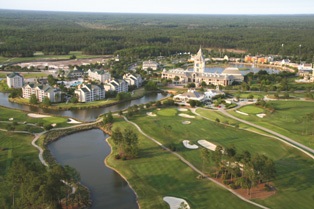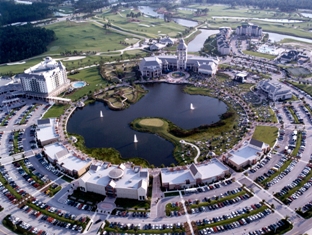 In May, 1986 final development approvals were received for a 6,300 acre mixed use project located off Interstate 95 in St. Johns County approximately 23 miles south of Jacksonville, Florida. The project encompassed 6,300 acres within six parcels and was granted development approvals for 13,835 residential units and over 6.5 million square feet of commercial, industrial and office use. The project was named St. Johns Harbour.
In May, 1986 final development approvals were received for a 6,300 acre mixed use project located off Interstate 95 in St. Johns County approximately 23 miles south of Jacksonville, Florida. The project encompassed 6,300 acres within six parcels and was granted development approvals for 13,835 residential units and over 6.5 million square feet of commercial, industrial and office use. The project was named St. Johns Harbour.
The proposed project was conceived by a pair of investors from Memphis, Tennessee who had purchased approximately 5,000 of the 6,300 acres as a land investment. Their initial attempts at selling portions of their property had failed to yield expected returns. In the early 1980’s development concepts in Florida were being dramatically influenced by the success of large master-planned communities in California. As California developers migrated to Florida with such companies as Arvida Corporation the master-planned community concept took hold. State and County government embraced the concept of larger communities with their inherent support infrastructure verses the smaller subdivision development concepts which relied heavily on local and state government to provide all base infrastructure. Most large community developments included not only residential but job generation opportunities such as support retail, office and industrial uses.
 The investors felt that once they received their development approvals they would be able to “flip” the project to a local developer for a good economic return or possibly participate long term in the development process. The approval process took three years to complete. The 1300 acres of non-owned acreage was included in the project development approvals in order to gain access to I-95.
The investors felt that once they received their development approvals they would be able to “flip” the project to a local developer for a good economic return or possibly participate long term in the development process. The approval process took three years to complete. The 1300 acres of non-owned acreage was included in the project development approvals in order to gain access to I-95.
In July, 1987 I was contacted by representatives of the investors and asked if Cobb Partners Development, Inc., of which I was President, would be interested in the project. After initially saying no to the opportunity I agreed to review the project information and approvals and give the investors my thoughts. In October, 1987 at a meeting in New York with the investors I presented my findings as follows:
Project Strengths:
1. Project approved as “Development of Regional Impact in May, 1986 prior to implementation of 1985 Growth Management Act in St. Johns County.
2. Project Location – South of Jacksonville – 3 miles frontage on I-95.
Project Deficiencies:
1. Project approvals encompassed 6,300 ac.; Investors only owned 5,000 ac. Remaining 1,300 acres not under contract and owned by five (5) individuals/entities. Non-owned acreage entitled through the development approval process was now more valuable therefore more costly to acquire. Acreage was not put under contract prior to development approvals being granted.
2. Development approvals required construction of a privately funded interchange on I-95 at Nine Mile Road.
• Without interchange – no access to project other than on local roads.
• Original interchange justified through Federal Highway Administration as traditional diamond configuration with an estimate cost of $3.5 million to construct excluding land. New requirements stipulated full cloverleaf design; with an estimated cost of $7.5 million excluding land. The full cloverleaf design also required twice as much land to construct interchange.
• Additional acreage required for interchange construction under many ownerships including FDOT and St. Johns County.
3. Significant title issues on both owned and to be purchased parcels including long term mineral and timber leases, non-relocatable easements and platted lots.
4. No existing environmental permits.
5. Approved development densities required cost prohibitive site infrastructure.
6. No project financing in place.
7. No project anchor had been secured nor development concept approved.
The meeting concluded with the investors asking for a recommended strategy to meet their investment goals. We agreed to meet again, this time in Memphis with a formalized action plan for their approval.







